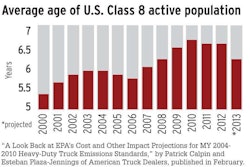Clean diesel engines will continue to be the dominant power source for heavy-duty vehicles in the United States for “decades to come because of their power and efficiency,” according to a study prepared for the U.S. Department of Energy.
The report – “Advancing Technology for America’s Transportation Future” – was authored by the Natural Petroleum Council at the request of U.S. Energy Secretary Stephen Chu. The two-year study examines fuels, technologies, industry practices and government policies through 2030 for auto, truck, air, rail and waterborne transport and potential industry and government actions that could reduce greenhouse gas emissions from American transportation by 50 percent by 2050.
“The National Petroleum Council findings confirm what transportation officials and industry leaders have already determined – that the continued advancements in clean diesel technology will continue to make diesel the dominant power source for heavy-duty trucks throughout the United States for decades to come,” said Allen Schaeffer, executive director of the Diesel Technology Forum.
According to the NPC report, diesel engines will remain the heavy-duty powertrain of choice for decades to come because of their power and efficiency. “There are, however, opportunities to improve the technology,” the report states. “Significant fuel economy improvements in diesel-powered trucks are possible. Indeed, the fuel economy (mpg) for new Class 7&8 HD vehicles, which consume more than 70 percent of the fuel in the trucking fleet, could be doubled.”
“Today, diesel powers more than 80 percent of freight movement in the U.S. and internationally more than 90 percent of global trade is moved by diesel engines,” Schaeffer said. “There is a reason today that diesel powers the overwhelming majority of the nation’s commercial trucking, school and transit bus fleets. Diesel’s unmatched combination of availability, safety, energy efficiency and economical operation and performance has made it the technology of choice, but it is also the environmental performance and prospects for even greater energy efficiency that make it the technology of choice for the future.”
Schaeffer said diesel technology advances have improved efficiency and reduced emissions to the point that diesel engines are now near-zero emissions. “The NPC report also highlights that diesel technology will continue to advance in the coming years,” he said. “Diesel’s role as a technology to increasingly power light-duty vehicles in the future was also recognized in the report.”
The NPC report examined several alternative fuel sources such as natural gas, which NPC said could make inroads into heavy-duty trucking “assuming that the current price spread between diesel and natural gas persists over time.” The report also highlighted the major infrastructure problems natural gas and other alternative fuel sources face.
“Deployment of a new fuel infrastructure is a significant hurdle to the adoption of new fuel-vehicle systems,” the report states. “It could cost tens to hundreds of billions of dollars to provide similar alternative-fuel availability as the current gasoline infrastructure and will take decades to fully deploy. Some fuels also require advances in supply-chain infrastructure technology to aid deployment. Specifically, advanced biofuels must overcome technology hurdles related to fuel manufacturing, and hydrogen must overcome technology hurdles related to dispensing infrastructure.”
The NPC study also coincides with a recent survey of industrial freight carriers that found less than 10 percent of senior executives currently “believe LNG will be widely adopted of over-the-road trucking.” The survey also found that while freight carriers generally were aware of liquefied natural gas-powered vehicles, 72 percent felt that the technology had limited adoption potential for industrial freight.
“The NPC report also recommended against having the government attempt to pick winners and loser in transportation,” Schaeffer said.
“There is a great deal of uncertainty regarding which individual fuel-vehicle systems will overcome technology hurdles to become economically and environmentally attractive by 2050,” the report states. “Therefore, government policies should be technology-neutral, while market dynamics drive commercialization.”









